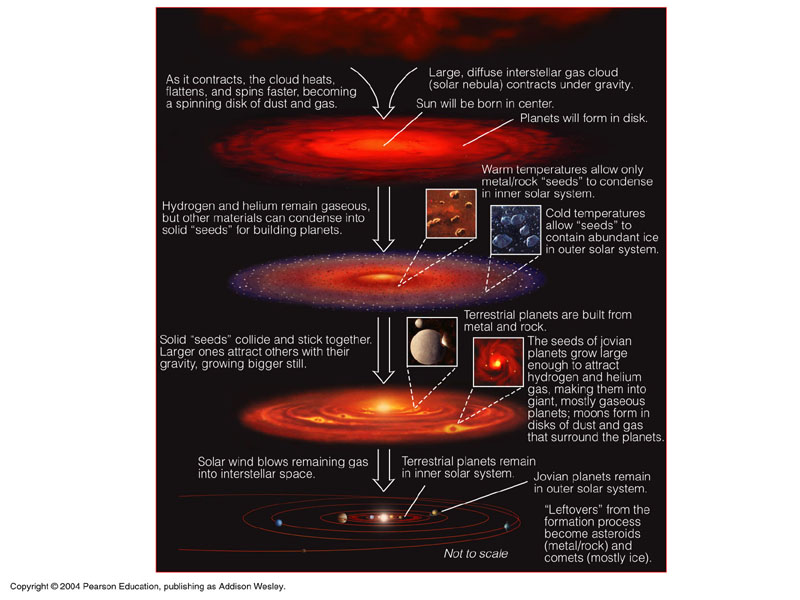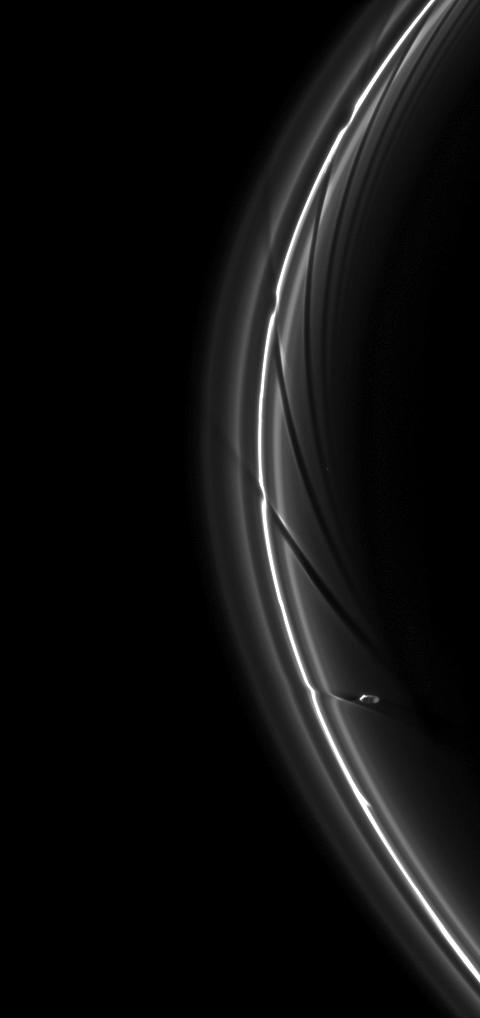Angular Momentum Distribution
Let's start with items 3, 4 and 5. These items seem to be accounted for by the idea that the initial cloud from which the solar system formed had a slight rotation (non-zero angular momentum). Recall that angular momentum cannot be destroyed, so any initial angular momentum will cause the protostar to rotate ever more rapidly as it collapes. This same rotation will cause the outer parts of the cloud to form a disk, and planets forming within that disk will have circular orbits and all lie in the same plane (the plane of the disk). Thus, this single idea seems to account for all three items 3-5 (except for Mercury and Pluto), and we might expect all solar systems to have planets that orbit in the same direction. See this interesting counter-example.
Item 6 is a little more tricky. It may seem natural that planets will form with the same sense of rotation as their orbital direction, which is also a consequence of conservation of angular momentum, and models of the behavior of disks seems to bear this out. But if so, why is the obliquity of the planets so different, especially Venus and Uranus? The answer seems to be in the process of formation of the planets themselves, which we will discuss in more detail shortly.
We also mentioned earlier in connection with the formation of the protoplanetary disk that there is much more angular momentum in the planets (99%) than in the Sun itself (1%). Thus, the angular momentum is all there, but seems to have been redistributed so that the Sun lost much of its angular momentum and the protoplanetary disk gained it. The mechanism that may account for this is magnetic breaking, where any magnetic fields in the original nebula would be greatly enhanced in the protostellar object, and those magnetic fields would interact with the disk, both slowing the Sun and speeding up the disk.
Temperature Gradient in the Solar Protoplanetary Nebula
Now let's take a look at items 1 and 2. During the collapse of the protoplanetary cloud, the inner parts would naturally heat up (conversion of potential energy into kinetic energy), while the outer parts would remain relatively cold. As the density of the cloud/disk increases, the dust and gas of the nebula would begin to cluster into larger flakes, but in the inner part of the nebula the volatiles (gases) would not form liquids or ices due to the high temperature. Thus, we can certainly expect that the inner solar system would be volatile-poor and the planets that form would be largely rocky or contain metals. When we model the conditions of the solar nebula, we find that the temperature reaches the "snow line," where water ice can form, just inside the orbit of Jupiter, and outside this orbit ices and liquids can exist. Planets are formed slowly from a coalescence (accretion) of the flakes of rock and metal in the inner solar nebula, or rock, metal and ices in the outer solar nebula. Thus, one might reasonably expect planets beyond the snow line to grow faster. Once a planet exceeds a critical size, its gravity is strong enough to hang on to gases as well. The inner rocky planets apparently never grew large enough to attrach the gas of the solar nebula directly, so they stayed small. The outer gas giants grew large enough, because of the existence of ices in their vicinity, to accrete the gas of the nebula directly, after which time they would have been able to grow rapidly. It is interesting that the larger planets would have had their own "planetary" system of moons forming in similar disks around each of them. The Galilean Moons of Jupiter make a nice example of this, with the inner moon, Io, being entirely rocky while the outer moons Europa, Ganymede and Callisto become progressively more icy.

The scenario depicted above, then, seems to account quite naturally for the main characteristics of our solar system, items 1-6, with a few exceptions like the obliquity of Venus and Uranus. It was once thought that item 7, too, might be explained as a natural consequence of the formation of the planets, given some kind of increasing radius of influence as the planets formed.
Other Observed Characteristics of the Solar System
Given the above scenario, we should see if it can also account for some other observed details, such as:
- The rocky planets and our Moon show evidence of heavy bombardment by large objects that left highly cratered surfaces. This is true of Mercury, the Moon, and Mars. By careful dating and other evidence, it is clear that this bombardment was mainly isolated to a specific period of time roughly 700 Myr after the formation of the Moon.
- The Earth, and perhaps Mars, has lots of water.
- We find lots of smaller bodies (the asteroids in the asteroid belt, Kuiper-belt objects, and comets) that we have to account for.
- There are some known timescales we have to account for:
- The protostellar object and disk must form roughly 105 years after collapse begins.
- Protostars go into a period of intense outward mass loss in the form of a violent wind between 105 and 107 years after they form. This suggests that any material in a protoplanetary disk is swept clear after about 10 Myr, so the planets better be formed by then!
- The oldest meteorites are 4.566 Gyr old, while the Sun itself is 4.57 Gyr (according to models), so meteorites must have formed quickly.
- Ages of rocks returned from the Moon, or ages of Martian meteorites, show that both bodies must have solidified no more than 100 Myr after the collapse of the nebula.
- The lunar surface underwent a spike of bombardment 700 Myr after the Moon formed.
Formation Mechanisms
One way or another, planets must form from the nebula fairly quickly. There are two competing formation mechanisms: 1) direct gravitational instability (a top-down mechanism) that builds planets by forming them directly from a local condensation in the nebula, and 2) accretion (a bottom-up mechanism) that builds planets starting with small flakes growing into larger bodies through collisions. We can estimate the size of the region (called the Hill Radius) around a fledgling protoplanet (a planetesimal) that is influenced by its gravity as follows: The period of a planet around the Sun is given by Kepler's 3rd Law P ~ 2p (a3/GMsun)1/2. Likewise, consider the radius at which the orbital period of a test particle around a protoplanetary mass M, is the same as the period of the protoplanet around the Sun, P = 2p(RH3/GM)1/2, where RH is the radius of the orbit, called the Hill Radius. Equating these two periods, we can solve for the Hill radius
RH = (M/Msun)1/3 a.
The significance of this is that if a test particle comes within the radius RH of a planetesimal of mass M, it can become gravitationally bound and the planetesimal continues to grow. Rather than working with mass, it is possible to convert this to a ratio of densities
RH = R (r /rsun)1/3 (a/Rsun).
This radius is generally much bigger than the radius R of the planetesimal, meaning that the planetesimal has access to a large volume of space. Consider that the planetesimal will orbit and eventually come into contact with anything within that radius around the entire orbit, which makes a considerable volume of the nebula available. Thus, planetesimals can grow surprisingly fast (of order 106 yr).
A large planet like Jupiter, beyond the snow line, would have grown a core by the accretion method until it was perhaps 10-15 Mearth. At that point, it becomes massive enough to attract and hang onto gases such as helium and hydrogen, and could then grow much more rapidly. Jupiter would grow until the gas was depleted, again taking perhaps 106 yr. More distant planets (Saturn, Uranus, Neptune) are progressively smaller mainly because the solar nebula's density would decrease outward. In the inner solar system, the last stages of accretion would have involved collisions between very large bodies. The Earth's Moon is thought to be the remnant of a body the size of Mars hitting the proto-Earth, stripping off mainly the outer crust of Earth which then collected into the Moon. It was during these very large collisions that rotation axes could get knocked helter-skelter. This could explain the upside-down Venus and sideways Uranus.
After 107 yr, the planets would have largely stopped growing, and the terrestrial planets would have been completely molten and devoid of any volatiles (no water). By that time, the Sun ignites (starts nuclear fusion of H -> He), and enters the intense T Tauri stage that sweeps the remaining dust and gas away.
